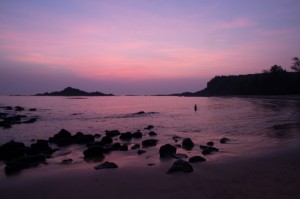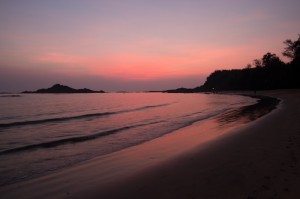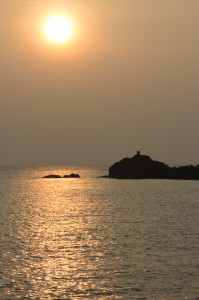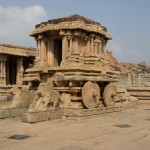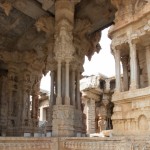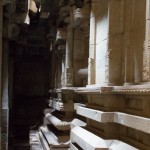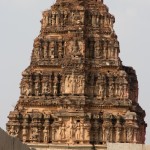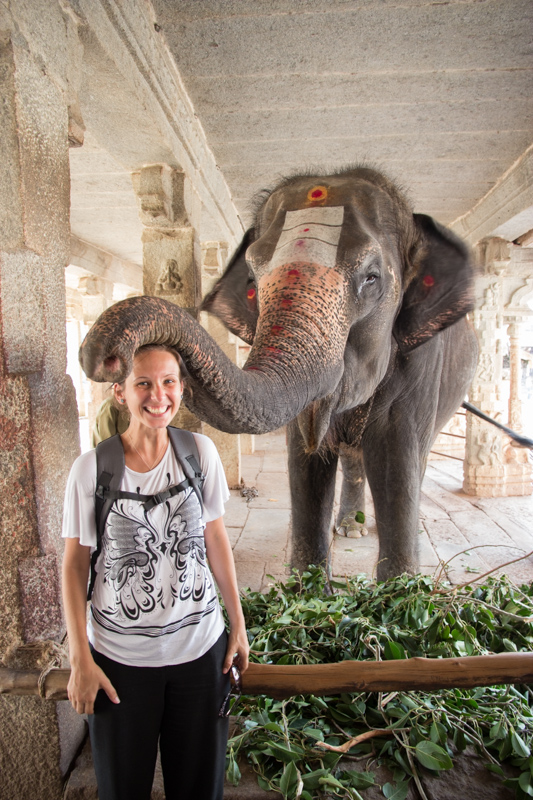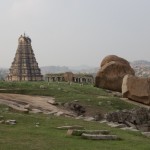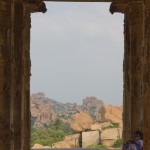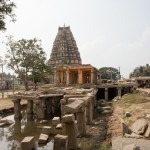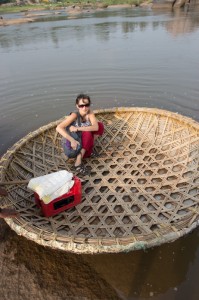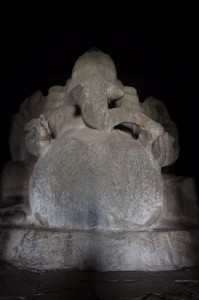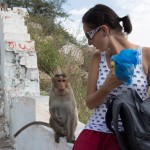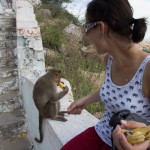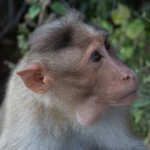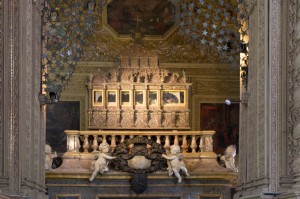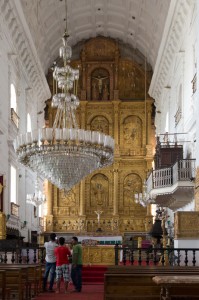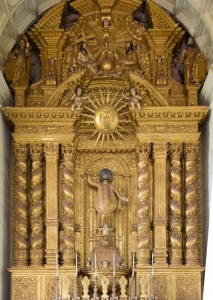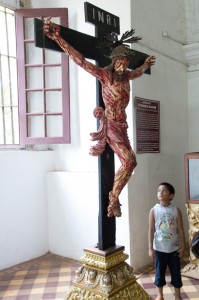The road rose sharply and wound its way up the mountain-side. As the car navigated around a sharp bend, the road seemed to disappear, as if we were riding on air. Two thousand meters below us the town of Mettupalayam sparkled in the noon sun. The buildings looked small and inconsequential next to the impressive mountain vista. Then, with a sideways pull, we were swinging back into the ascent and the car ploughed onwards and upwards into the dense, green foliage that covered the steep climb. Up ahead a waterfall cascaded down a cliff face, the spray catching the light that filtered down through the trees, refraction spilling rainbow beams in our path. The road twisted round and once again we found ourselves peering out over the grand drop. The journey carried on this way for another hour, and steadily we rose through the layers of cloud which sat around us for a time; as thick fog. All of a sudden we emerged into the light, strong sunshine chasing away the remaining tendrils of mist. Before us was the plateau of the mountain, ridges rising on both sides, and there in front of us stood Ooty.
Our journey had started eighteen hours before. We climbed onto the train from Mangalore and slowly passed through the rich countryside. The track rose above the many rivers that criss-crossed our path and elevated on the trellised track we could see for miles around. This leg of the journey was particularly remarkable, for we were the only two people on our carriage for quite some time. The sensation was both a little unsettling and deeply relaxing, for trains had so far, been microcosms of the outside world. Hot, noisy and packed with people.
Mangalore led onto through the lowlands of Kerala and into the state of Tamil Nadu, the land undulating and rising up as we navigated the Western Ghats. Eventually, and in the pitch black of a late evening we arrived at Coimbatore, the largest city in Tamil Nadu. We changed here for Mettupalayam and the new train pushed up higher into the hills. As dawn broke, the silhouettes of large mountains became clear on the horizon. Mettupalayam was a small station with a single platform for handling traffic on the broad-gauge lines. On the other side of the station a second platform was flanked by meter-gauge tracks and there at the end of the track sat a small steam engine which was being prepared to take a miniature set of carriages up through the mountains and onto our final stop.
As much as I wanted to ride the train to the top, practicality took a foot forward and we debated the other choices for a minute. The miniature train would take four hours, whereas a taxi would take half that time. Travel weary, we decided to go for the taxi, resolving to take the steam engine another time.
Ooty formed an abrupt first impression as we climbed out of the car in front of our hotel. Having left the muggy, thirty degree heat at the bottom of the mountain, we were startled to find the air both very thin and incredibly chilly. Stood in our shorts and tee-shirts, we decided that a change of wardrobe would be required before we emerged from our hotel room and scoured our bags for more layers to wear to dinner that evening.
Looking about the town we were quickly taken by its charm. It was the first place in India we had been that took a little pride in the appearance of its store-fronts and roads. Everywhere you looked there were notices promoting the reduction of litter and again for the first time so far, actual public bins, spaced both numerously and intelligently enough to be of public service. Indeed it looked like all the locals were on-board with the motion, as wherever we looked the town was both clean and tidy.
A sense of Britishness also permeated this community. Ancient popcorn machines – like the ones you would see in the old small-town cinemas of days past – stood in the doorways of shops, men stood ready to serve up the treat in clear bags. Outside restaurants you could find the menus atop wooden plinths, and you were given the time and privacy to peruse without an overzealous waiter haranguing you to take a seat. Even the design of the town reminded me of home, with a central road focussing the town’s supply of services and goods rather than a more spread out manner; of which other Indian towns seem to adopt. Overall though it was probably the cold, autumnal weather that made us think most dearly of home.
Having been away for a couple of months already and also having had left before it got cold in the UK, it seemed to me that summer had not really ended. So arriving at the top of this mountain, shivering in my shorts, my body went into a sort of natural lockdown, an urge to hibernate came over me, just as a bad cold took hold, and I retreated to the hotel room for forty hours, till the boredom of sitting in one room drove me back out into the fresh air despite still being a little too ill to really appreciate what was going on around me. None-the-less we took a rickshaw up above the town, through the tea plantations laid out in tiered rows across the ridge, up past the workers busy laying a new mountain road, to a giant white building with the words ’TEA FACTORY’ stamped on the side.
Inside we had a five rupee tour of the working factory, getting to see the machinery at work on the raw leaves that had been bought in from the plantations. The further we walked into the factory, the finer the leaved were chopped and tumbled, and then chopped again. They moved on to conveyor belts which dried out the moisture and then an oxidisation took place which turned them brown from green. Finally the produce was sifted into large sacks and taken away for sale. At the end of the line, a gent stood by with a tray of tea for us to taste and refresh our senses with.
The tea factory was a great move, and gave us chance to see the town from the higher elevation. The peak rose further above the town however, and we resolved to come back and hike to the summit which we did a couple of days later. The climb was long and we had the added competition of fast jeeps charging up the trail behind us, requiring us to stop and move aside so they could push past. Finally we made it to the top with a couple hours of daylight to spare. Unfortunately for us a large cloud had smothered the peak in a thick blanket of mist which for a time limited our vision to a handful of feet in front of us. We bought some lemon tea from a vendor set up at the peak and waited it out. Sure enough a small break came in the clouds and we had a partial view of the plateau below. After a while we had to turn and retreat down the mountain before darkness set in. Luckily at the end of the peak trail a large bus came swinging round the corner which we hailed and rode back into town.
We had now been in Ooty for about a week and really enjoyed the diverse attractions on offer. There was a boating lake which we spent a few hours leisurely floating on before heading across the road to a museum called the ‘Thread Garden’. This large shed charged a nominal fee to come in and look at the ‘world miracle of plants recreated with just thread’. These ‘plants’ had been constructed by fifty specially trained ladies over the last twelve years and then put on display for all to bask in their magnificence. The rhetoric and hyperbole was through the roof on this attraction, and we stayed just long enough to get some photos before moving swiftly on. We visited the ‘Botanical Gardens’ which was really an arboretum and spent an afternoon lazing around its grounds before retreating to one of the many local tea shops and a pot of the Nilgiri special.
Finally we decided we should move on and caught a taxi back down the mountain to the train station. Our plan is to head into Kochin in Kerela, and navigate the backwaters on a house boat. Stay tuned for more adventure!
